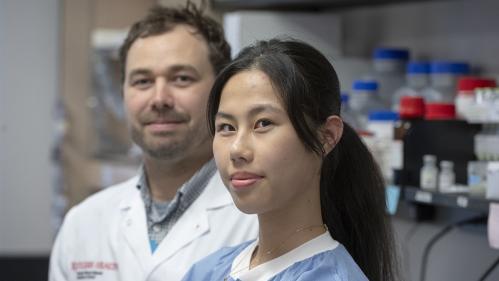Rutgers Researcher Teams Up with Local High School Student to Discover Potential Treatments for Addiction Disorders

A Rutgers researcher has teamed up with a local high school student to build a machine-learning approach for screening current and existing drugs to determine which could potentially become effective treatments for addiction-related disorders.
Morgan James, assistant professor of psychiatry at Robert Wood Johnson Medical School, core member of the Rutgers Brain Health Institute, and member of the executive board at the Rutgers Addiction Research Center, has been working on developing better treatments for psychiatric illnesses characterized by aberrant motivation, such as eating disorders, substance use disorders, and depression.
James has focused on the orexin system, which regulates “various physiological phenomena such as wakefulness, feeding, reward, and thermogenesis” and which, according to him, is involved in a wide range of psychiatric conditions, including addiction. He explained that there are experimental drugs that block signaling at a particular orexin receptor and could potentially treat addiction and some types of eating disorders. Unfortunately, he said, these experimental drugs remain just that and have so far failed to gain regulatory approval for use in the clinic.
“We set out to discover which drugs could impact the orexin 1 receptor,” said James. “What we know about pharmacology is that many drugs have so-called off-target effects, so a drug might be developed to hit receptor X, but it may hit receptor Y as well, and we want to find the drugs whose receptor Y is the orexin 1 receptor.”
The Orexin system features two receptors – orexin 1 receptor and orexin 2 receptor. According to James, the orexin 1 receptor is important for stress, panic, motivation, and craving, including for drugs of abuse and food, while orexin 2 receptor is more important for wakefulness and arousal. He believes that targeting the orexin 1 receptor exclusively could reduce drug and feeding behaviors such as craving and relapse without putting the patient to sleep. The orexin system is different from the focus of popular diabetes medications that mediate appetite and satiety, whereas the orexin system impacts motivation.
“The orexin system takes your environmental information, for example the sign of your favorite restaurant, and turns that signal into craving and motivation. If you can interfere with that system, it reduces the motivation to go to get the food,” said James. “The same goes for things like drugs of abuse, such as cocaine and heroin. We believe that it is really important to impact the system that translates environmental information into drug-directed behavior.”
However, instead of attempting to create an entirely new drug, James took a novel approach; he decided to focus on existing medications to determine if their off-target effects include blocking the orexin 1 receptor. To do this, he received help from Vanessa Zhang, a student from West Windsor - Plainsboro High School South and champion figure skater, to develop an artificial intelligence method to screen all existing drugs to determine if they may have so-called off-target effects at the orexin 1 receptor.
“Vanessa made contact with me through William Welsh, who is a professor in the department of pharmacology and a long-time collaborator of mine,” said James. “Vanessa is a very accomplished figure skater, where she has witnessed eating disorders among her peers, so working on this project was a way to help address the problem by combining two of her interests, machine learning and eating disorders. She took on the project of creating the algorithm, with guidance from myself and Professor Welsh, and has done an amazing job.”
Zhang explained what inspired and motivated her to take part in the project, including the use of computational methods.
“Eating disorders are a prevalent issue in figure skating,” said Zhang. “As a competitive figure skater, I’ve witnessed the detrimental impact these mental struggles have on skaters’ health and careers. I wanted to make a change in the skating community, and this passion inspired me to conduct scientific research with the hopes of finding new eating disorder treatments.”
She added, “Professor James’ project on the orexin 1 receptor especially appealed to me because this receptor represents a new approach to combating eating disorders. Furthermore, I was very excited to use computational methods while researching, and Professor James was very open to this approach.”
Although there are no clinically-available drugs that act on orexin 1 directly, there are experimental compounds that do. James and his team collected those compounds into a database to better understand why and how they impact the orexin 1 receptor. That information was then used to create an algorithm that predicts the likelihood of another drug being able to do the same or similar.
“We developed a machine-learning program to determine what features predicted the likelihood of a drug acting at the orexin 1 receptor, and the algorithm did a really good job of doing that,” said James. “We then looked at 1,600 compounds that are FDA approved, so theoretically available to give to humans, and that produced a short list of candidate drugs. We carried those out in vitro screening, essentially testing each drug in a dish to see if it acts at the orexin 1 receptor. We found several of our candidate drugs had some of the features we are looking for.”
“My favorite part of this project was the process of developing the machine learning model,” said Zhang. “Although it was a learning experience and full of trials and errors, each failure motivated me to learn more methods and refine my approach. Ultimately, I learned how to use a diverse array of computational tools to create a model that could contribute to the project’s success.”
Satisfied with the knowledge that the process worked, James and his team turned their patented AI method to a database of almost 20 million chemical entities, and then focused on the top 100 results to test further in vitro.
The AI platform as well as certain candidate drugs that were discovered during the process have been patented through the Office for Research’s technology transfer department, and James and his team will continue their medicinal chemistry study to find drugs that have high promise on their own and could potentially be modified to become viable medications focusing on the orexin system.
“The Office for Research’s technology transfer team have been great – they always are,” said James. “We went to them pretty early on, once we'd found data, and worked with them to discuss if there was anything patentable there, and they helped us delineate two patentable things: the platform, the AI approach to screening drugs, as well as some of the compounds that popped out in our initial screening that could potentially be repurposed to exploit their actions at the orexin 1 receptor. They helped us draft and file the provisional application and have been supportive all the way.”
“Working with Dr. James goes hand-in-hand with the Office for Research’s mission to support the research, scholarship, and creative endeavors of all Rutgers faculty,” said Deborah Perez Fernandez, executive director of Technology Transfer. “His research into addiction disorders could become the key in addressing an issue that impacts so many people and families around the world.”



